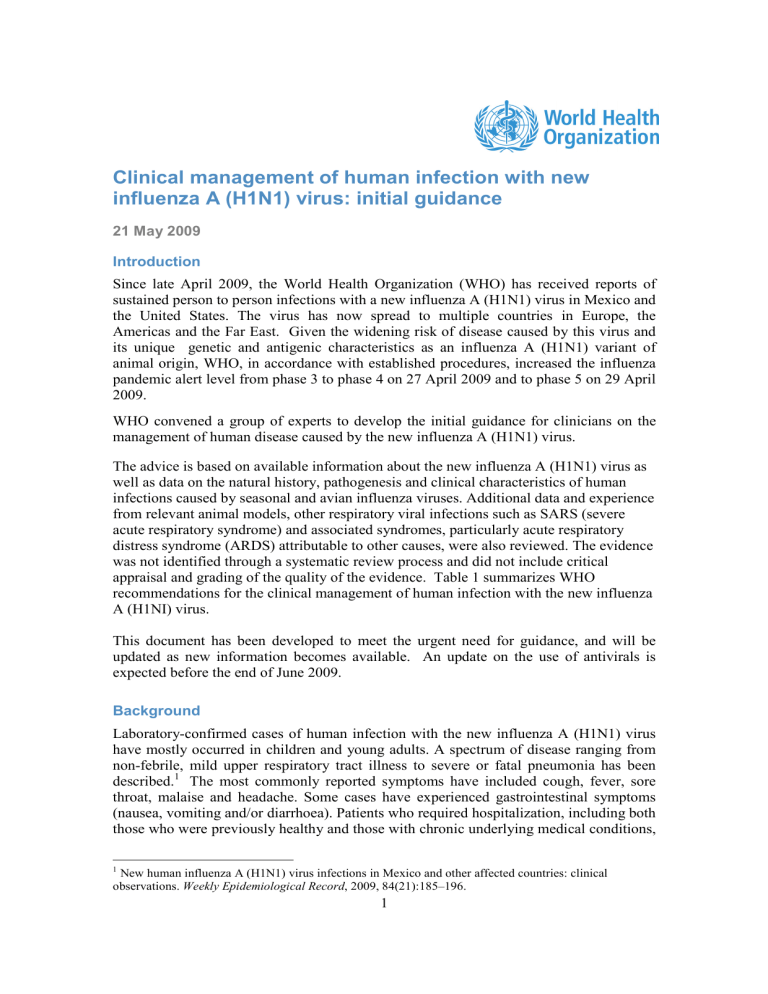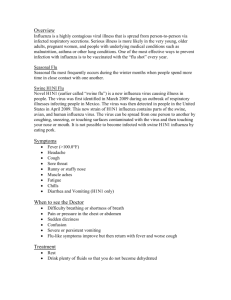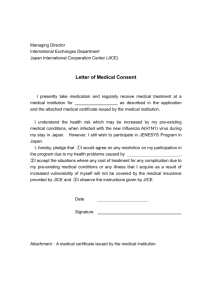Clinical management of human infection with new

Clinical management of human infection with new influenza A (H1N1) virus: initial guidance
21 May 2009
Introduction
Since late April 2009, the World Health Organization (WHO) has received reports of sustained person to person infections with a new influenza A (H1N1) virus in Mexico and the United States. The virus has now spread to multiple countries in Europe, the
Americas and the Far East. Given the widening risk of disease caused by this virus and its unique genetic and antigenic characteristics as an influenza A (H1N1) variant of animal origin, WHO, in accordance with established procedures, increased the influenza pandemic alert level from phase 3 to phase 4 on 27 April 2009 and to phase 5 on 29 April
2009.
WHO convened a group of experts to develop the initial guidance for clinicians on the management of human disease caused by the new influenza A (H1N1) virus.
The advice is based on available information about the new influenza A (H1N1) virus as well as data on the natural history, pathogenesis and clinical characteristics of human infections caused by seasonal and avian influenza viruses. Additional data and experience from relevant animal models, other respiratory viral infections such as SARS (severe acute respiratory syndrome) and associated syndromes, particularly acute respiratory distress syndrome (ARDS) attributable to other causes, were also reviewed. The evidence was not identified through a systematic review process and did not include critical appraisal and grading of the quality of the evidence. Table 1 summarizes WHO recommendations for the clinical management of human infection with the new influenza
A (H1NI) virus.
This document has been developed to meet the urgent need for guidance, and will be updated as new information becomes available. An update on the use of antivirals is expected before the end of June 2009.
Background
Laboratory-confirmed cases of human infection with the new influenza A (H1N1) virus have mostly occurred in children and young adults. A spectrum of disease ranging from non-febrile, mild upper respiratory tract illness to severe or fatal pneumonia has been described.
1
The most commonly reported symptoms have included cough, fever, sore throat, malaise and headache. Some cases have experienced gastrointestinal symptoms
(nausea, vomiting and/or diarrhoea). Patients who required hospitalization, including both those who were previously healthy and those with chronic underlying medical conditions,
1
New human influenza A (H1N1) virus infections in Mexico and other affected countries: clinical observations. Weekly Epidemiological Record , 2009, 84(21):185–196.
1
have frequently experienced rapidly progressive, serious lower respiratory tract disease.
Other well-recognized influenza complications in those seriously ill with the new influenza A (H1N1) infection have included secondary bacterial infections, rhabdomyolysis with renal failure, myocarditis, and worsening of underlying conditions
(for example, asthma and cardiovascular disease).
In order to improve understanding of the disease and refine optimal case management,
WHO urgently requests additional clinical and treatment data from the regions and countries where patients infected with the new influenza A (H1N1) virus are being treated.
Whenever possible, clinical data and serial samples for virological monitoring should be collected prospectively in the context of a clinical protocol, starting before treatment, to allow assessment of the effects of treatment regimens. Retrospective reporting of clinical and laboratory data from patients who had recently been infected may also be helpful.
Reporting clinical findings and treatment outcomes to WHO will greatly facilitate the better understanding of the new disease and the development of further management guidance.
Draft reporting forms are available at: http://www.who.int/csr/resources/publications/swineflu/caseformadapted20090508.pdf
Infection control
Appropriate infection control measures (Standard plus Droplet Precautions) should be adhered to at all times. Whenever performing high-risk aerosol-generating procedures
(for example, bronchoscopy, or any procedure involving aspiration of the respiratory tract) use a particulate respirator (N95, FFP2 or equivalent), eye protection, gowns, gloves, and carry out the procedure in an airborne precaution room that can be naturally or mechanically ventilated, per WHO guidance.
2
Diagnosis
Laboratory confirmation of the new influenza A (H1N1) virus, especially at the beginning of a new community outbreak, or for unusual cases, has important implications for case management, including those pertaining to infection control procedures, consideration of antiviral treatment options and avoiding the inappropriate use of antibiotics. Currently, the confirmatory diagnostic tests can be done by specialized laboratories
3
in many countries. Reverse transcriptase polymerase chain reaction (RT-
PCR) will provide the most timely and sensitive evidence of infection with the new influenza A (H1N1) virus. Clinical diagnosis (based on the acute onset of fever and cough) can be increasingly predictive of the new influenza A (H1N1) virus infection as the prevalence of infections increase.
At present, there is no validated rapid bedside diagnostic test for the new influenza A
(H1N1) virus infection (including so-called “point-of-care” diagnostic tests).
2 http://www.who.int/csr/resources/publications/infection_control/en/index.html
3
WHO can assist with laboratory testing. See http://www.who.int/csr/disease/swineflu/guidance/laboratory/en/index.html
2
Commercially available rapid tests for seasonal influenza have uncertain sensitivity and lack specificity for detection of the new influenza A (H1N1) virus. If these tests are performed, both positive and negative results should be interpreted with caution.
Samples for laboratory tests should be taken from the deep nasal passages (nasal swab), nasopharynx (naso-pharyngeal swab), throat or, if available, bronchial aspirate. Upper respiratory tract sampling using a combination of a nasal or nasopharyngeal and a throat swab is advised and may facilitate virus detection. It is not yet known which clinical specimen gives the best diagnostic yield for this specific infection. Specimen collection should be done with appropriate precautions since this may expose the collector to respiratory secretions from patients.
General treatment considerations
To date, most human cases of new influenza A (H1N1) virus infection have had uncomplicated illness of limited duration. Hospitalization or antiviral therapy is therefore not likely to be required for most patients. Supportive care includes antipyretics, such as paracetamol or acetaminophen for fever or pain, and fluid rehydration and can be provided as needed. Salicylates (such as aspirin and aspirin-containing products) should not be used in children and young adults (aged <18 years) because of the risk of Reye’s syndrome.
The specific risk factors that predict increased risk of progressive disease are incompletely understood. Clinicians and caregivers should watch for signs of possible clinical deterioration (for example, difficulty in breathing, chest pain, coughing up coloured sputum, altered level of consciousness and confusion) and refer such patients immediately to hospital. Clinicians should also take into account any underlying comorbidities (such as immune-compromising conditions, pre-existing chronic lung or cardiovascular disease, diabetes).
Pregnant women are known to be at increased risk of complications from seasonal, avian
H5N1 and previous pandemic influenza infection. Several hospitalizations including fatal outcomes have been reported in pregnant women infected with the new H1N1 virus.
Consequently, pregnant women with suspected or confirmed new influenza A (H1N1) infections warrant closer observation and, if in accordance with national policies, treatment with antivirals (see below).
Oxygen therapy
At presentation or triage and routinely during subsequent care in hospitalized patients, oxygen saturation should be monitored by pulse oximetry whenever possible.
Supplemental oxygen should be provided to correct hypoxaemia. The WHO recommendations for pneumonia advise oxygen therapy to maintain oxygen saturations above 90%; however, this threshold may be increased to 92–95% in some clinical situations, for example during pregnancy. Populations at altitude will require different thresholds for diagnosing hypoxaemia but will also have increased susceptibility to severe hypoxaemia in the presence of pneumonia or ARDS.
3
Patients with severe hypoxaemia need high flow oxygen (e.g. 10 litres per minute) delivered by face mask. Some patients who experience difficulties with compliance (such as children) may require the close involvement of nursing staff or family members.
Where piped oxygen is not available, a supply of large cylinders will be needed. WHO has included oxygen in its List of Essential Medicines since 1979, but oxygen is still not widely available in some countries. If medical oxygen is not available, industrial oxygen can be used.
4
Oxygen treatment of newborn infants should follow guidelines
5
.
Antibiotic treatment
Antibiotic chemoprophylaxis should not be used. When pneumonia is present, treatment with antibiotics should generally follow recommendations from published evidencebased guidelines for community-acquired pneumonia
6
. However, seasonal influenza and past influenza pandemics have been associated with an increased risk of secondary
Staphylococcus aureus infections, which may be severe, rapidly progressive, necrotizing, and, in some areas, caused by methicillin-resistant strains. The results of microbiological studies, wherever possible, should be used to guide antibiotic usage for suspected bacterial coinfection in patients with the new influenza A (H1N1) virus infection. Several patients in Mexico have developed ventilator-associated pneumonia or hospital-acquired pneumonia caused by typical nosocomial pathogens .
Antiviral therapy
The new influenza A (H1N1) viruses are currently susceptible to the neuraminidase inhibitors (NAIs) oseltamivir and zanamivir but resistant to amantadine or rimantadine
(adamantane or M2 inhibitor drugs).
7
Since the H1N1 virus is new, clinical efficacy data on antiviral treatment are not yet available. Based on its in vitro susceptibility patterns and clinical experiences derived from seasonal and avian H5N1 influenza infection, early administration of NAIs might reduce severity and duration of illness caused by the new H1N1 virus infection, and might also contribute to prevent progression to severe disease and death. Antiviral therapy may be beneficial especially for the following groups:
• pregnant patients, in whom administration of antiviral medicines should be carefully evaluated taking possible benefits and risks into consideration;
• patients with progressing lower respiratory disease or pneumonia;
• patients with underlying medical conditions.
If used, antiviral treatment should ideally be started early, but it may also be used at any stage of active disease when ongoing viral replication is anticipated or documented. It is possible that the virus may replicate for a prolonged period of time in some patients as a result of the lack of pre-existing protective immunity.
There are important pharmacological differences to consider when choosing NAIs for
4 http://whqlibdoc.who.int/hq/1993/WHO_ARI_93.28.pdf
5 http://whqlibdoc.who.int/publications/2003/9241546220.pdf
6 http://whqlibdoc.who.int/publications/2006/924159084X_eng.pdf
(for pregnant women and newborns)
7 http://www.cdc.gov/mmwr/PDF/wk/mm5817.pdf
4
treatment. Oseltamivir is administered orally and gives higher systemic level . , Zanamivir is delivered by oral inhalation with low systemic absorption. Oseltamivir is the recommended treatment for lower respiratory tract complications.
Rare neuropsychiatric symptoms such as confusion or abnormal behaviour have occurred after beginning treatment for seasonal influenza with oseltamivir, particularly in children and adolescents,
8
but the contribution of oseltamivir to these events is unknown. Inhaled zanamivir has been temporally associated with bronchospasm and patients with preexisting airway disease appear to be at increased risk for this severe adverse reaction.
Any suspected adverse events should be reported to national regulatory authorities. Table
2 gives the recommended antiviral treatment regimens by age and weight.
Corticosteroids
Corticosteroids should not be used routinely to treat patients with the new influenza A
(H1N1). Low doses of corticosteroids may be considered for patients in septic shock who require vasopressors and have suspected adrenal insufficiency. Prolonged use of or highdose corticosteroids can result in serious adverse events in influenza virus-infected patients, including opportunistic infection and possibly prolonged viral replication.
Advance respiratory support
Treatment of ARDS associated with the new influenza A (H1N1) virus infection should be based upon published evidence-based guidelines for sepsis-associated ARDS. Lungprotective mechanical ventilation strategies should be used.
9
8 http://www.fda.gov/medwatch/safety/2008/safety08.htm#Tamiflu
9
For example, http://www.survivingsepsis.org/system/files/images/2008_Guidelines_Final_.pdf
5
Table 1: Summary of clinical management of the new influenza A (H1N1) virus infection
Modalities Strategies
Antibiotics In case of pneumonia, empiric treatment for community acquired pneumonia (CAP) per published guidelines pending microbiologic results
(e.g. 2-3 days); tailored therapy thereafter if pathogen(s) identified.
Antiviral therapy If treatment needed, oseltamivir or zanamivir. The new influenza A (H1N1) virus is currently resistant to amantadine and rimantadine.
Corticosteroids Moderate to high dose steroids are NOT recommended. They are of unproven benefit and potentially harmful.
Infection control Standard plus Droplet Precautions. For aerosol-generating procedures use particular respirator (N95, FFP2 or equivalent), eye protection, gowns, gloves, and an airborne precaution room, that can be naturally or mechanically ventilated, per WHO guidance
10
.
NSAIDS, antipyretics
Paracetamol or acetaminophen given orally or by suppository. Avoid administration of salicylates (aspirin and aspirin containing products) in children and young adults (< 18 years old) due to risk of Reye’s syndrome.
Oxygen therapy Monitor oxygen saturation and maintain SaO2 over 90% (95% for pregnant women) with nasal cannulae or face mask.
Table 2: Recommended antiviral treatment regimens
Oseltamivir
Oseltamivir is indicated for treatment of patients one year of age and older. For adolescents (13 to 17 years of age) and adults the recommended oral dose is 75 mg oseltamivir twice daily for 5 days. For infants older than 1 year of age and for children 2 to 12 years of age recommended doses are as follows:
15kg or less
15-23kg
30 mg orally twice a day for 5 days
45 mg orally twice a day for 5 days
24-40kg
>40kg
60 mg orally twice a day for 5 days
75 mg orally twice a day for 5 days
Zanamivir
Zanamivir is indicated for treatment of influenza in adults and children (>5 years). The recommended dose for treatment of adults and children from the age of 5 years is two inhalations (2 x 5mg) twice daily for 5 days.
10 http://www.who.int/csr/resources/publications/infection_control/en/index.html
6


